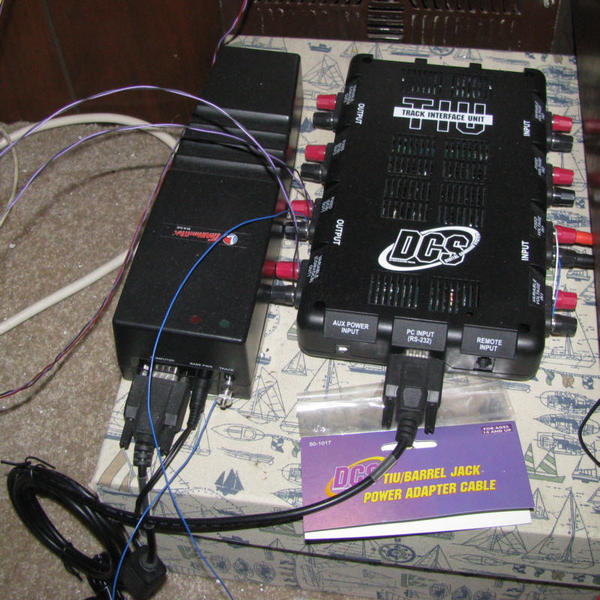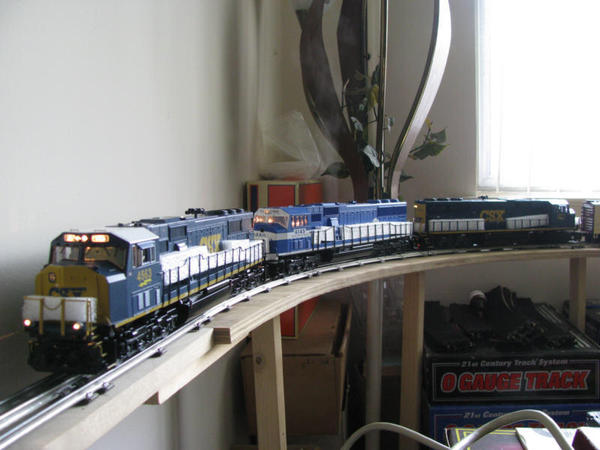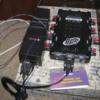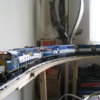(I started writing this when 'mjrodg3n88's last post was only 7 minutes old..sometimes my posts take a while to write  )
)
For the longest time, conventional control meant one loco per transformer.
Some transformers had two or more controls built-in (such as the ZW). You still had one loco per control, and running trains on both controls meant they had to be on physically separate loops of track.
Connecting the two loops with crossover switches usually meant electrically separating them, primarily by replacing the center-rail pin between the two switches with a plastic one. Each train becomes capable of changing tracks, with the complication being that if one train moves onto a track occupied by another, both trains are being run by one control handle and you lose independent control.
--Since both trains may run at different speeds for a given voltage, you'd likely have trouble keeping them from running into each other without adding even more insulating pins to create sections of track you could disable with power switches, thus stopping one of the trains. But this is starting to get complicated, and you still don't really have independent control of the two trains.
Enter command control.
The idea with command control is you (or the factory) outfit each loco with a circuit board that acts like a miniature robo-engineer that only responds to commands sent specifically to it by way of a remote that talks to a control box that either sits between the transformer and the track or in parallel with it. One power source supplies the track at a constant voltage (usually 16-18 volts), but the locomotives suitably equipped only take what they're told to do. This means multiple locos on the same track can all be controlled independently.
The two main systems on the market are MTH's Digital Command System (DCS), controlling Protosound 2 and 3 locomotives (Protosound 1, or PS1 isn't command control--it's only a sound board in a conventional loco) and Lionel's Legacy system, which is an updated, expanded version of Trainmaster Command Control (TMCC), also made by Lionel.
Both systems can control conventional locomotives, albeit with the same restrictions of traditional transformer control outlined in my first four paragraphs.
--With DCS, the ability to do so is built into two of the four outputs on the control box, called a Track Interface Unit (TIU).
--Under TMCC or Legacy, this requires a separate box called a 'track power controller' (TPC) that connects to the TMCC/Legacy command base and acts as a remote-controlled transformer handle.
A DCS system can operate TMCC locomotives in command mode by connecting a TMCC or Legacy Command base to the TIU via a cable supplied by MTH as shown below:

Lionel made the control codes for TMCC public, as well as licensing the system out to a number of other manufacturers in an effort to standardize its system, which made DCS control of a TMCC command base possible. However MTH kept its DCS control codes a closely-guarded secret (and when Lionel developed Legacy, it also chose to keep the additional feature codes a company secret). The end result of this is DCS can operate a connected TMCC or Legacy command base, but it can only issue TMCC-level commands to Legacy locomotives. A TMCC or Legacy remote isn't able to talk to the DCS system at all.
Both systems can co-exist on the same layout. Since their transmission styles and protocols are different, you can run locos from both systems on the same track without interfering with one another:

In the above pic, the lead unit is a DCS loco, the one coupled behind it is a TMCC unit. I ran these coupled together pulling a train using just a DCS remote (at the time I didn't have a TMCC remote), switching back and forth to sync up their speeds. It was a real juggling act, but I pulled it off.
By the way, locos from all the above systems will operate in conventional--just that the advanced features won't be accessible.
---PCJ








